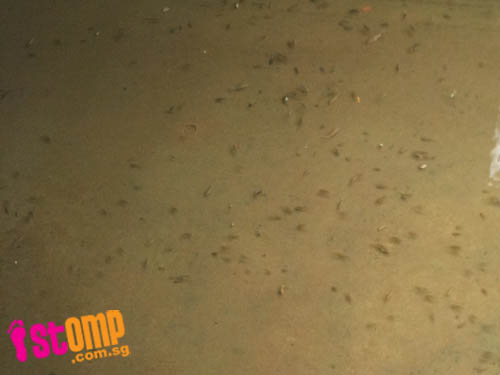
STOMPer John was amazed at the swarms of little fish that live in this large drain in Jurong West. He wonders if anything can be done to turn the drain into a real river.
In an email today (Jun 1) the STOMPer wrote:
"Hi, I would like to share a few pictures I took this afternoon.
"When I walked past the 'longkang' (drain) , I saw hundreds of thousands of these fishes.
"They are not 'Luohan' (Flowerhorn fish) as they appeared silver in colour when they flipped themselves to find food.
"They are all kind of sizes. I really hope our 'longkangs' can be like Bishan, which really turned into a river.
"Please, SAVE THE FISHES first! They are amazing to watch."


Our urban drains and canals can be very challenging environments for aquatic life. These habitats typically have little to no aquatic vegetation, and the concrete channels mean that there are few hiding places. There may be frequent fluctuations in temperature, oxygen level and pH, while in hot weather, the flow of water may be reduced to a trickle or dry up altogether. Pollution may be a significant problem in certain areas, especially close to industrial and residential districts.
What I have noticed is that for many of these urban waterways, the dominant fish species are not native to Singapore. These include various species of livebearers (F. Poecilidae) and cichlids (F. Cichlidae), and the East Asian river goby (Rhinogobius giurinus). In larger canals and rivers, it may also be possible to find some species of carp (F. Cyprinidae) and armoured catfishes (Pterygoplichthys spp.). However, there are some native species of fish which might be found living in urban canals and drains, such as climbing perch (Anabas testudineus), whitespot panchax (Aplocheilus panchax), Asian swamp eel (Monopterus albus), common walking catfish (Clarias batrachus), and common snakehead (Channa striata). Closer to the sea, where there is tidal influence, these species may be joined by others which are adapted to estuarine and inshore habitats.
I have found it interesting to note that a large proportion of our freshwater fish species are not native, and that even introduced species differ in terms of the habitats in which they are more likely to be found. For example, many introduced species are restricted to reservoirs, lakes and ponds, which have very different environmental conditions compared to urban canals. Some hardy species, such as guppy and Mozambique tilapia may be abundant and dominant species in both habitats, whereas species like giant snakehead (Channa micropeltes) and tiger barb (Puntius tetrazona) are more likely to be found in reservoirs, ponds and rural streams.
It may be argued that introduced species pose a threat to natives in our reservoirs and forest streams, whereas for urban drains and canals, it's not clear if these non-native fishes are outcompeting native species in these habitats, or if they are filling empty ecological niches in habitats inhospitable to most of our native freshwater fishes. These non-native species are an important food source for piscivorous birds such as herons (F. Ardeidae), terns (F. Sternidae), kingfishers (Alcedines) and raptors (Accipitriformes), and may be a crucial factor in supporting populations of these birds in areas which may otherwise be lacking in prey.